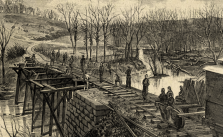Grand Tactician: The Civil War (1861-1865) – Retreat
Retreat
Quickly escape an engagement to a safe location (another unit, a fort, a city, or a town). A rearguard will try to keep the enemy at bay and skirmish. An unsuccessful retreat may turn into a rout, which will disorganize the army and cause straggling and desertion, plus loss of morale. All the units taking part in a battle (including reinforcements) will be tied to that engagement until concluded and cannot be reinforced in other battles.
If you take command in a battle, once the fighting is concluded, you will return from the battle level back to the campaign as soon as the battle starts. The units involved will then be locked in the combat for as long as the battle lasts, which can be multiple days. This mechanism allows multiple player-controlled battles to take place concurrently. A cunning commander may try to lure enemy reinforcements away with a feint attack while the main body engages with some delay simultaneously.
Auto-resolved combat takes into account a wide variety of data from the opposing armies, including the personalities of the commanders, and these battles can last multiple days as well.
An ongoing battle is depicted on the campaign map by the units firing at one another. The engaged units are shown with crossed sabers on the NATO symbol, indicating the units are locked in this battle and unavailable in others. In the above image, Pope’s army has engaged a fort, garrisoned by Stewart’s division, besieging it.
A 3-D monument will appear on the site of the battle, and a balance bar is shown. The monument will offer tooltips about the engagement, and the balance bar shows who has the advantage in the battle. The NATO symbol of your unit will show the estimated victory chance and expected duration of the battle.
Monuments depicting major engagements will be left on the map to remind players of these great battles. Monuments of insignificant battles will eventually be removed from cluttering the map. The same is true with naval engagements.












